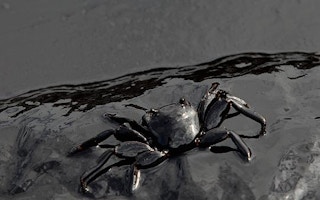Demand for seafood has plunged on the back of last week’s oil spill, while local fisherman fear the disaster’s long-term environmental impacts could devastate their industry.
Werasak Dolnarong, a member of Rayong’s local fishermen network, said fishing incomes had fallen since the leak took place last Saturday. He said there had been a sharp drop in seafood consumption in the province.
However, he noted this was only a short-term effect of the spill.
Mr Werasak said he was more concerned about the long-term consequences of the oil slick on marine ecology and fishing stocks.
Authorities were warning the slick would soon hit Mr Werasak’s home town of Ban Pe in Rayong’s Muang district.
As of press time yesterday, however, the toxic black sludge had yet to arrive.
“So far, there is no clear study on the damage to marine ecology and how long it will take to recover,” Mr Werasak said.
“If recovery takes a long time, or if the damage is irreversible, fishermen will be the hardest-hit group.”
A seafood merchant at Suan Son beach, also in tambon Ban Pe, said seafood prices had dropped sharply since the oil leak, as news about crude oil contamination had driven away tourists and seafood buyers.
The vendor said her income had halved since the spill.
The Fishery Department has assured consumers that Rayong seafood is safe as the oil slick affected only a limited area.
The department said the slick had affected about 100 sq km of the fishery zone.
Five of the department’s artificial coral reef sites, covering about 15 sq km, were also damaged.
An initial survey conducted by the department found 534 local fishermen were hit by the spill and the subsequent drop in seafood prices.
These fishermen usually earned 1,200-1,500 baht per day.
Fishery officials have been keeping a close watch on possible damage to 45 fish and shellfish farms in Ao Pe, Ban Pak Klong Kreng and Pak Klong Lawon.
Ratana Munprasit, director of the Centre for Fishery Research and Development in the Eastern Gulf of Thailand, said there had been no reports of oil contamination of marine animals in areas other than Koh Samet’s Ao Phrao, where a large quantity of oil washed up on Sunday.
She added the department had collected sea water and marine animal samples on Koh Samet every day since the spill and had so far found no toxic contamination.
Fishery Department chief Wimol Jantrarotai on Thursday said the long-term impact of the oil slick on marine ecology must be closely monitored.
“We can’t tell yet what will happen [to marine life] in the long run,” he said. He admitted the use of dispersant chemicals could be harmful to marine life.
Scientists have warned the dispersants can become more toxic when mixed with oil.
Rayong governor Wichit Chartprasit said the province had set up a centre to hear complaints from people effected by the oil spill. About 200 people - 90% of them fishermen - had registered with the centre so far, he said.
Meanwhile, the Department of Marine and Coastal Resources yesterday said a preliminary study on marine ecological damage would be completed next week.
Pinsak Suraswadi, a member of the department’s special taskforce dealing with the spill, said the study would focus on coral reef sites at Ao Phrao.
“There is no scientific method to repair damaged coral reef. Only nature and time can heal them, but this means human activities must be minimised,” he said.
He could not tell how long Ao Phrao would need to close for to allow the marine ecology to rehabilitate, as that would depend on the severity of the damage.










